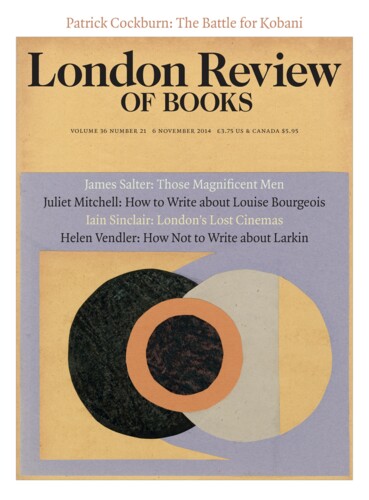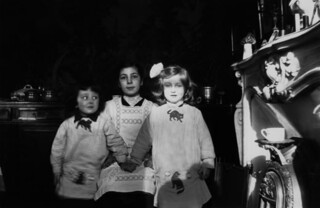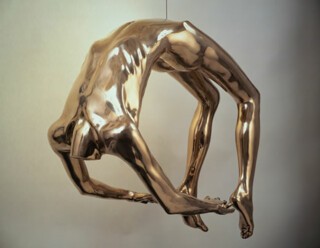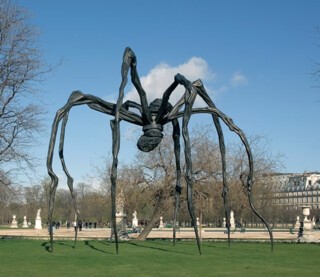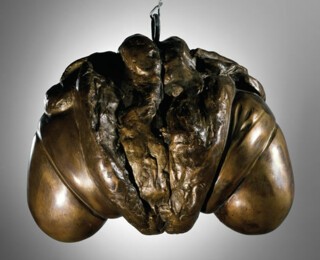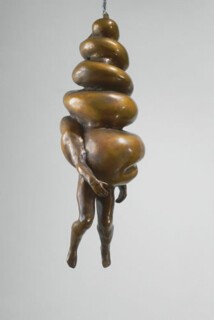Louise Bourgeois died, aged 98, in May 2010. Shortly before her death Jerry Gorovoy, her long-time assistant, found a forgotten box of her jottings, unpublished papers and diaries from her time in psychoanalysis. He had uncovered a similar stash six years earlier; together, the materials came to a thousand pages of notes. Some of the writings were displayed, along with a selection of drawings and sculptures, in the exhibition Louise Bourgeois: The Return of the Repressed, which travelled in Latin America, then came, in a smaller version, to the Freud Museum in London in 2012.
In the summer of 2011, I spent a week in the Bourgeois archive near the brownstone where she had lived in Chelsea (New York). I hoped to find out about her relationship with her younger brother, Pierre. His presence pervaded her psychoanalytic notes, which I had examined, but I couldn’t see much trace of him in her art until the 1990s, more than thirty years after his death. The absence was striking. But something else was nagging at me. The catalogue for The Return of the Repressed was accompanied by a volume of essays on Bourgeois and psychoanalysis. In my own contribution I had subscribed to the accepted story that Pierre never recovered from the shellshock he had suffered as a soldier in the Second World War. But shellshock was an odd explanation; a term used for soldiers traumatised in the First World War, it had been displaced by a different vocabulary in the Second. I wondered whether my own interests, in siblings and their maladies, might be more pertinent. As I sat in the archive, surrounded by boxes full of papers, a small, stiff brown leather suitcase, marked by age, was fetched for me. It had not yet been catalogued, so wasn’t used in the exhibition. In it, among a mix of unsorted papers, clinical documents and family letters, I found what I was looking for.
Pierre was born in 1913, the younger brother to three sisters, one of whom died before Louise was born. The family lived in a vast house on the Bièvre river in Antony near Paris, where they ran a business repairing antique tapestries – at a young age Louise assisted with the drawing. As small children Louise and Pierre were inseparable, and wrote to each other fondly when they were parted. But Pierre lagged well behind Louise at school, and never fully found his way.
We know little about his life. He was a troubled young man. He tried to escape conscription but in 1934 his father, Louis, forced him into France’s compulsory military service. For some time he lived on his own in the family house, undertaking so-called renovations, but his father arranged to have him evicted on the grounds that he was destroying the property. After a breakdown in 1945 Pierre hoped to come and live with Louise and her family in America. Fearing his mental state, she let him down, and the move did not happen. He was labelled with the (then) catch-all diagnosis of ‘schizophrenia’ and institutionalised. He died in his sleep in May 1960, aged 47.
Louise was thirteen months old when Pierre, the longed-for boy, was born. She always both wanted and did not want him. This is a normal ambivalence on the part of an older child, which can echo through life. It did for Bourgeois. I was astonished to find my own idiosyncratic interests in sibling relations so powerfully pre-empted not only in Bourgeois’s art but also in her psychoanalytic thinking. ‘There is something wrong with me,’ she wrote in March 1964. ‘I love to / search / who, my brother? … / For what is wrong with me = I am ashamed / For my remedy to it = I am guilty / This might have appeared as early as the 2d / year of my life.’ It was a confirmatory revelation: an artist always gets there first.
Bourgeois’s father died unexpectedly in April 1951, when she was 39. It was then that she entered a prolonged and intensive psychoanalytic treatment with Henry Lowenfeld, a Freudian with a special interest in art who had escaped Germany with his wife in 1938. She already had a good sense of psychoanalytic theory through her contact with the Surrealists in prewar Paris. Once in America, she became an extremely well-read and hard-working analytic patient. Her full analysis with Lowenfeld lasted from 1952 to 1967; after that, she remained in touch with him and had two further intensive but brief periods of therapy. After Lowenfeld’s death in 1985, she continued a self-analysis through her art, her written reflections and what she called her ‘pensées plume’, or ‘feather-thoughts’. ‘The cost of Parents fixation (one of the cost[s]) is your total inability to deal with siblings,’ she wrote in her diary in September 1986. Combining this recognition with her knowledge of psychoanalysis, she realised that something important was missing, both from the narrative she had constructed of her own life and from the theory of psychoanalysis.
Published accounts of child analysis abound with children whose first outbreak of neurosis or psychosis coincided with the arrival of a new baby in the family. The child, Freud wrote, feels that
it has been dethroned, despoiled, prejudiced in its rights; it casts a jealous hatred upon the new baby and develops a grievance against the faithless mother which often finds expression in a disagreeable change in its behaviour. It becomes ‘naughty’, perhaps, irritable and disobedient and goes back on the advances it has made towards controlling its excretions. All of this has been very long familiar and is accepted as self-evident; but we rarely form a correct idea of the strength of these jealous impulses, of the tenacity with which they persist and of the magnitude of their influence on later development.
When Bourgeois started analysis, her preoccupation with the past had more than an element of hysterical reminiscing, the flowery path of nostalgia – what Elaine Showalter called the hysteric’s propensity for ‘hystories’. But the treatment enabled her to make a story of hysteria itself, which then became an object for her art. Through this process, Bourgeois came to know that although our past permeates our present, it is nevertheless past. Furthermore, we cannot re-construct a pure past but only attempt a construction. This will be real enough, but it will bear traces of our false memories and our imaginings.
Through her art and through her work with Lowenfeld, Bourgeois transformed the hysterical aspects of her personality into an understanding and representation of hysteria. Her Arch of Hysteria figures of 1993 are often referred to as ‘androgynous’. If instead we see them as bisexual, a different perspective opens up. Charcot, Freud’s teacher in the 1880s, was famous for his conviction that male hysteria existed and was prevalent and for his photographs of women (mainly) in hysterical postures, most often the backwards-arched body. Bourgeois’s figures capture the association with both genders in one image – the two-in-one of bisexuality.
Central to all this is ‘ambivalence’. In psychoanalysis as elsewhere the term refers to the simultaneous experience of two opposing emotions. For the infant, to experience love and hate for the same object at the same time is a normal state of affairs; the baby screams, the toddler rages. As adults, we separate out our emotions: we think we love some people and hate others. But what we have once known we still know, at some psychical level. The point of ambivalence is not only that we experience opposing emotions at the same time, but that the experience is one of conflict. That flash sensation of simultaneous opposites is a moment of madness. It can be experienced by anyone; Bourgeois experienced it, over and over. Her life and work were permeated by jealousy and generosity, envy and gratitude, destructiveness and reparation, hate and love. Ambivalence was everywhere but it was at its untenable height with Pierre, her untenable brother.
Bourgeois explored the ambivalence the hysteric tries to deny; she had known it very clearly in the extraordinary strength of her passion for her father, but also in her feelings for her mother and for Pierre. In her feminist narratives of hate and love for her parents, she wore her ambivalence on her sleeve. In Maman (1999), her mother is an enormous, fragile yet rapacious spider. In the thirty-feet-high, cragged steel cathedral formed by her legs, she embraces everyone; she is both frightening and beautiful, dangerous and reparative with her basket of marble eggs. In Bourgeois’s earlier work, the installation The Destruction of the Father (1974), her father Louis is fêted and feasted on, the primal father in Freud’s Totem and Taboo. Innards are displayed on a wooden table in a red-lit room with black velvet floor and ceiling: a cannibal family meal in a threatening cave.
Ambivalence towards a sibling plays out differently from ambivalence towards parents, both in psychoanalytic terms and in Bourgeois’s work. It should be understood in the context of bisexuality, particularly in Bourgeois’s case, since her most significant sibling was a boy. Where ambivalence involves a relationship to another person, bisexuality refers to our identity as sexual subjects. Today, the term is used most commonly to refer to a person’s sexual orientation: the attraction to both sexes. For our purposes, we need to restore the sense it had when it was first picked up by Freud in the late 19th century: whatever one’s object choice, whether hetero, homo or ambi-sexual, somewhere one is, psychically, both sexes.
Adults tend to treat boys and girls differently from very early on, but the infant’s bisexuality precedes its own subjective experience of gender. The meaning of gender distinction only comes into focus when an unwelcome new baby arrives – or when the infant fears that it will, as it might have seen happen, say, to its friend – and is either the same or a different sex. Thereafter bisexuality as a subject position, like the feeling of ambivalence, is experienced only fleetingly, as two genders present at the same time. A girl who knows and feels she is a girl experiences herself at the same time as a boy, and vice versa. And, as with ambivalence (but in the case of bisexuality, only after infancy), the complete simultaneity cannot be sustained. The psychic pendulum swings from one to the other, or one dimension remains hidden and subjugated to the other. Because, at one time, we were happily bisexual, this is a both/and, not an either/or position, though as Bourgeois’s work demonstrates, the dominant mode will shift according to context, or one’s stage of life.
It was in her portraits of bisexuality that Bourgeois hid the secret life of Pierre in the work that followed his death. He was the crucial partner in her exploration of her bisexuality. What she creates as a sculptor out of her own subjectivity becomes an object for her, and for us, to love and hate. Janus Fleuri (1968) is boy and girl. There are two clitorises or two flaccid penises; in between them is a representation of the female genitals experienced from inside. They look as if touched they would respond with pleasure. Stasis and movement are captured in bronze – a hard material made to represent softness. The title of the piece reminds us that most flowers contain both male and female elements. ‘It is perhaps a self-portrait,’ she said of the sculpture in September 1969, ‘one of many.’
Bourgeois subscribed to Melanie Klein’s account of the violence, and remorse for that violence, felt by the baby towards the mother. It was Donald Winnicott who pointed out that the mother hates the baby before the baby hates her. Bourgeois’s own experience as a child and as a mother (she had three sons) had taught her that the ambivalence between mother and child goes both ways. For her the mother became, the art historian Mignon Nixon writes, ‘a figure that sustains ambivalence and aggression: not only an object of ambivalence or a figure produced with the help of ambivalence, but a figure in which the creative power of ambivalence is lodged’. Bourgeois knew well the child’s anger which persisted in her own adult self; for her, the creative shock was the unbearable realisation that her mother must also have been ambivalent towards Louise, the beloved daughter. This was crucially linked to the birth of Pierre. Louise discovered as an old lady what she had unwittingly known as a toddler. In the early days of her analysis, she often calls herself a ‘goody-goody’. She had hidden her jealousy under a determination to be best. She had tried to become in every way the most successful and favourite child; but she was not a boy, and could never win back the status of her mother’s one and only beloved baby. It was only after she had made Maman, which incorporated the spider’s ambivalence towards herself, that Bourgeois was able fully to articulate what she had identified as her theme long before. ‘I attempt to represent the problem of ambivalence,’ she wrote in her notes around 1960.
For Klein, the breast is a ‘part object’ that represents the mother: the part for the whole. Sculpted part objects (particularly the breast and the penis/clitoris), as in Janus Fleuri, feature widely in Bourgeois’s work. But although there are a few representations of her brother – an etching, for example, from 1939 – she could not find a summative image for him until after the death in 1990 of her adopted son, Michel. (She had adopted him in 1939 because at the time she believed she could not bear children.) ‘Michel is a second Pierre … took Pierre’s place,’ she wrote in April 1952. Louise will have wanted to be the ‘little mother’ of Pierre – but her mother was his mother; her nanny, his nanny. When finally she does come to represent Pierre, she articulates her ambivalence through the parallel experience of bisexuality. The bust in Cell XIV (Portrait) from 2000 has the appearance of raw flesh erupting but imprisoned in a cage. Here Louise and Pierre are fused together, but are also as separate as ears on either side of a head.
When Pierre was born, Louise was ‘replaced’ by the longed-for boy. Bourgeois’s psychoanalytic writings are strewn with reflections on being the second-best ‘second sex’. ‘I am afraid that my parents like my brother better than me,’ she writes in April 1959, reliving the past for her therapy, ‘because I am only a girl that is what is wrong with me. [W]hat is wrong with me?’ The year before she teased herself about her resentments: ‘He has something that has been stolen from me so he has stolen it from me – how else do you explain that you have it when I have lost it (logic, evidence).’ But she is left with a sense of emptiness: ‘I have nothing … goes straight back to Pierre’s birth.’
Louise, the one-time baby, will have expected the new baby to be a continuation of herself. Their twin-like identification and resemblance will have persisted: she thought of Pierre as her double, but also as her ‘shadow’. ‘Almost Sames, yet different’: a markedly ambivalent relationship of adoration and sadism, joy and despair. To love Pierre ‘as herself’ is to incur the threat of her own annihilation, so she will have wanted to get rid of him both for taking her place in relation to their mother and for killing her rudimentary sense of her own subjecthood: ‘I attempt to represent the problem of ambivalence … the law of the jungle is to kill or be killed.’
Klein’s youngest patient, Rita, was two years and nine months old when she revealed her violent fantasies of attacking what she thought was inside her pregnant mother. For the infant, according to Winnicott, the arrival of a new baby entailed a ‘trauma of separation’ from the mother. I add that it is also a sibling trauma. At barely 13 months, Louise had to become overnight the ‘big girl’. She stood up and, for the first time, walked away from her mother and the new baby. ‘When Pierre was born Maman said – Louise got up and she walked. Maybe I was just afraid to fall at that moment – Vertigo and great fear of balconies,’ she wrote in 1958, suffering from these in her mid-forties. The theme is apparent in Spiral Woman (1984), in which a female figure, made up of or encircled in coils, is suspended above a black hole, representing the potential annihilation of identity experienced by the toddler as she is replaced by the usurping baby, and by the hysteric in all of us whatever our age.
Louise was furious that Pierre had the penis that should have belonged to her – ‘To be authoritarian as a woman, the young brother becomes her P,’ she writes in September 1957; P = penis/père/Pierre – but Bourgeois is explicit that it is not Pierre’s castration but his murder she wanted and wants: a sibling desire, not an Oedipal one. But she feels guilty too that with her greater charm and intelligence she was able, sadistically, to upstage him: ‘I am more clever, I bet on the charm.’ She feared she may have wanted – and that through a child’s cruelties she helped cause – Pierre’s life to go wrong. That was because he was other to herself. But because he is also the ‘same’, she fears his fate will be her fate: ‘I have Pierre’s trouble and will fall apart slowly and surely, so the sooner the better, and let us be through with it,’ she writes.
Finally Bourgeois abandoned Pierre. The theme of abandonment recurs in her life and work. Her father abandoned her by going to fight in the First World War; her mother abandoned her by having a new baby, by accepting the children’s tutor, Sadie, as her husband’s live-in mistress, and by dying early; Louise herself abandoned her family and France: Do not abandon me (2011) is the title of her late work with Tracey Emin. Significantly, too, there was Pierre’s ill-fated desire to take refuge in New York after the war. At first Louise encouraged him. She helped with the visa and said that he could come to live with her, Robert and their children. Pierre sold his maternal inheritance – a garage in Clamart – and with the money booked his passage from France to the US. But Louise balked, and asked their father to stop Pierre leaving, without letting Pierre know she had intervened. Louis carried out her wishes but thought Pierre had guessed Louise’s role. Three years after Pierre’s death in 1960, she wrote:
my brother has been violent broken everything and
he might be dangerous – I am told that I should not
go back home
…
what shall I do about my brother. I thought
the doctors said that he was cured
… well he was not
cured obviously –
… as far as Pierre is concerned
I still don’t know what to do, but I am going to find out
from him Pierre and from myself I am a grown up
afterall, and so far Pierre has not hurt me
I will find a way –
we will together, after all he does not
like violence himself and I love him.
The toddler fears the violence in herself that she sees reflected in the violence she fears in the new baby; the one finds its mirror in the other. Thus violence circulates. Bisexuality is in play here too. In working out its own gender, the child will always experience some undertow of bisexuality: the other sex which one is supposed not to be, but which inexorably remains. In her twin-like resemblance to him Louise feared Pierre could be the murderer she had discovered in herself. Writing in her diary in 1948 about having prevented his coming to New York, she has a fantasy conversation with her husband, the art historian Robert Goldwater:
L. The way things are going next time we find ourselves with a murder to cope with – what does that do to us?
R. What do you mean?
L. What does it do to your friends and to your job.
R. Nothing.
L. Wouldn’t it do something to you to have your pictures and his all over the papers –
R. My pictures would not be in the papers.
Alive or dead, Pierre would always be there for her, abandoning her through his illness as she abandons him through her success; reflecting, mirroring, as sporadically violent as she is sometimes sadistic.
‘Rarely in modern or postmodern art has a body of work been so tightly bound by narration,’ Robert Storr, an authority on Bourgeois, has said of her work. The works he has in mind are characterised by ambivalence: the presence of narrative in them is the mark of a splitting and re-joining of the two poles of ambivalence. Violence and destructiveness permeate these works, and sexuality too. But not bisexuality. The pieces I see as being concerned specifically with bisexuality (and therefore with Pierre) as a crucial aspect of her subjectivity are not narrative works. They are many, but they reach an apotheosis in the series of Janus sculptures, of which Janus Fleuri is the most famous. ‘Louise told me on a number of occasions that of all her works Janus Fleuri was her favourite sculpture,’ Philip Larratt-Smith recalls. ‘She would discuss the classical references and ask me whether I saw the twin elements of its hanging form as breasts or penises, as if it were a Rorschach … I could never tell if she was purposely withholding something … Janus Fleuri prompted no narrative, no biographical anecdote, no explanation of why she saw it as a self-portrait.’
Janus Fleuri is an exemplary study in bisexuality as a subject position rather than an object choice. The subject position is clearly not singular: ambivalently ponderous and flowery, this is herself as a boy and a girl, looking both ways, Janus-like. Although she referred to it as a self-portrait, elsewhere she said that she was also ‘interested in the portraiture of a relationship’. The crucial relationship here is that of Louise and Pierre. For a long time, he was missing in her art. Apparently she even removed Pierre’s image from the family meal in The Destruction of the Father after it was first exhibited. She had loved Pierre’s playful, admiring presence but also yearned for his failure, for her sick brother not to exist. Bourgeois may well have grasped that siblings were a lacuna within psychoanalysis because their absence in psychoanalysis was matched by her own failure for so long to face and ‘narrativise’ Pierre.
With Pierre, ambivalence is interwoven with bisexuality and there will be no narrative, not even any thematic portraiture (with one exception, the bronze ‘death mask’ portrait of 1965), until the agonised cloth heads of the mid-1990s. This is not to say that after his death in 1960 there isn’t a marked change in her work. She finds her sculptural feet and the new pieces – Amoeba (1963-65), Tits (1967), Fillette (1968), Avenza (1968-69) – urge the pleasure and puzzle of a bisexuality that set the terms of her relationship with Pierre. But with the cloth heads, she pushed through to the personal conflicts that had stayed hidden because they were too unbearable to face. A pioneer of feminist art, Bourgeois realised that her task was not to personalise the political but to politicise the personal. Her art and her use of psychoanalysis was a political task because what she feared and condemned in others, she found in herself (and vice versa.) Because she found the murderous violence in herself, she could portray it; because it is in all of us her portraits make us see it differently.
Maman, The Destruction of the Father and the Cells series (1991-2008) are family narratives. The cloth heads are something different. These severed heads portray that moment, which cannot be borne, when opposites – love and hate, girl and boy – are lived simultaneously. The heads show the unbearable as unbearable. For Bourgeois, this was trauma. ‘Art is the experience, the re-experience of a trauma. But what I am also saying is that it is a temporary state,’ she said. Paradoxically, this is right. Bourgeois captures the shock of trauma and gives permanence to its moment, fighting against the trap of its ceaseless repetition in what psychoanalysis knows as the ‘repetition compulsion’. She does this in and through depictions of the knot of ambivalence and bisexuality; and in doing so, she makes the unconscious conscious. This is a proper politics of the personal. But it also lends to psychoanalysis an artist’s access to the inexpressible. Her work reminds psychoanalysis of its fundamental investment in ambivalence and in bisexuality as a universal subject position, and it asks us to recognise the crucial importance of the sibling relation. This is what I found inside the small suitcase.
Send Letters To:
The Editor
London Review of Books,
28 Little Russell Street
London, WC1A 2HN
letters@lrb.co.uk
Please include name, address, and a telephone number.
